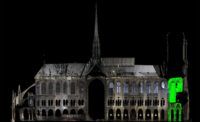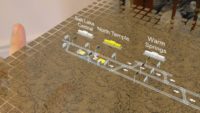While new technology is captivating, realizing the benefit of its capabilities relies upon effective implementation.
There is always an illusion — a risk — with something cutting-edge, such as laser scanning, that makes some see it as a silver bullet to improve the manufacturing process and ensure quality automatically.
The reality is that a good quality control process is important. In order to effectively manage quality, stakeholders need to know enough about the basics of laser scanning to understand what they are looking at and to validate their data.
Because laser scanning is still transitioning from cutting-edge to universal adoption, many leaders are working to build capabilities and modify their existing quality assurance/quality control processes to accommodate its introduction.
Staff need training to optimize laser scanning’s use. In a cross-section of a wall or floor, a crisp and defined line is ideal but failure to perform quality checks can result in multiple lines offset from one another by fractions of an inch, causing confusion as to which line is the correct measured object.
Installation of new equipment is another example where the quality of the scan is critical. If the scan has imperfections, new equipment will not coordinate with existing equipment layouts and costly changes in the field will be required to meet the installation schedule.
Despite being a huge advancement, laser scanning is not automatically “a silver bullet” for quality. The fundamental principles of QA/QC have not changed—it is always about having someone check the work, whether the work is aided by technology or not. Maintaining the effectiveness of the QA/QC program is the cornerstone of successful implementation.
Appropriate Supporting Technology
A learning curve comes with any new technology or process, and laser scanning is no exception. It’s still new enough to have a novelty factor and is not yet widely adopted, so the training offered in most cases is very high-level.
Training courses cover practical workflow implementation and how to incorporate laser scans into existing 3D models, but few courses offer practical training on quality assurance. Manufacturers sometimes include quality assurance training as part of the purchase support for a new laser scanning product, along with software and hardware instruction, but many more people outside the purchasing realm need hands-on QA instruction.
Industry experts understand the value of it, but figuring out how to implement it while continuing a robust quality program is still a future goal for many companies. While there are people teaching laser scanning methods, those training programs are not currently widely broadcast. The product is still entrenched in the marketing phase and companies are still learning how it works, not yet how they can make it work for them.
Harnessing the potential of the technology starts with challenging the assumption that software automatically reduces the amount of work and time it takes to complete a task. This is partly true, but the process must be in place to support the technology.
No one-size-fits-all device works for reality capture, along with at least 60 different options for laser scanners, over 100 different types of drones are on the market — with different camera options for each. There are specific use cases where one is superior to another, so it is important to do the research and find the best equipment for the job and know when to call on other professionals for support.
Hands-On Scan Data
This could start with a class covering basic tips on recognizing whether a data set is good or needs to be re-registered, and how to put the puzzle back together.
Experts with prior 3Dmodeling experience can become acquainted with the capabilities of laser scanners in short order — likely the same experts who have been champions for BIM in the past will help bolster the internal knowledge of your chosen laser scanning tool. This is the next phase of a solid reality capture and laser scanning work flow.
Once acquainted with the basics, experts can work with teams completing registration, which is a special skill set, outside the normal tasks of a designer. A short QA/QC class on the tools can help designers know what to look for, such as walls that aren’t registered correctly. Even if they can’t fix it themselves, the ability to spot issues and coordinate with project teams who have the in-depth skills to teach them what to look for and notice is an essential part of a good QA/QC program.
Specific, Realistic Expectations
Process experience is still key as laser scanning adoption increases, with scanner manufacturers generating excitement about the next wave of technology, but potentially overselling the ease of use.
It is important to create specific, realistic expectations. The process is not as simple as importing all the information into the software and clicking a few buttons. The essential skill set of QA/QC is still crucial to performing registration well.
Like any specialized skill, it takes years of experience to optimize the process and develop a critical eye to find errors before they become problems in the field. Training is a good start, and as the technology becomes more mature, the scanning industry will begin to see fewer errors, but vigilance is important in the early years of adopting any new technology.
Once implemented with due diligence, laser scanning can provide valuable time savings, and, in turn, cost savings.
In one example project, laser scanning helped a project team translate the original design intent from the decision makers as they performed more of the detailed engineering. The project involved installing a process tower that would infringe on existing equipment and interrupt production, which was not an option.
Because they had old documents that had some information gaps, laser scanning proved invaluable in figuring out how to work around the existing production process by providing validation that wasn’t possible during early design efforts.
The project had a very constrained timeline, so the team couldn’t take the risk of lost revenue by dividing up equipment and rerouting production close to the start of construction. This type of challenge is common and laser scanning enables teams to quickly recognize potential problems and change course on the design without losing much time, rather than designing almost to completion and having to issue change requests and ask for additional funds later in the process.
Another example project included installation of tall silos for Post — a food manufacturer. The team had to validate how they would get the silos, which were twelve ft in diameter, into a highly confined, tight space.
The silos had to fit on a certain type of trailer that was difficult to maneuver into an area of the plant where the silos needed to be located. The project team also had to utilize a crane to install the silos without shutting down any surrounding traffic or buildings.
In addition to the spatial challenges, the team was working within very tight tolerances that are common for such equipment. The SSOE project team used two different types of reality capture—laser scanning and a drone—to create a plan for installation of the silos with the crane. The simulations were invaluable in assuring that the silos could be delivered and installed without impacting daily operations, shipping and trucking lanes, all in a tightly compact site. The installation process had a very small margin of error for clearance between the top of the truck bed and the steel bottom of a large canopy, given the height of the silos and their 12-ft diameter.
The simulation was helpful for choosing a transport trailer that could hold the silos without accidents involving low-lying bridges and other obstructions. The site was nestled among older subdivisions with narrow streets and small turning radii, so the simulation was necessary from the beginning to the end of the route. Once on site, the crane had to move and rotate while positioning the silo in tandem with a fork truck, tilting and lifting the silo as they slowly placed it in position. In the end, they installed the silos successfully and had the entire simulation as well as the installation video for use on future projects.
Expedient, Error-Proof Future Asset Management
When laser scanning is used, the output is similar, but the process is more expedient and error-proof.
The point cloud data is delivered as part of the design process and many decision makers find the data useful for other capital programs that can benefit from lessons learned.
Throughout the process, decision makers are educated on the capability of the software and the data they receive, as well as strategies for storing the large scan files. This knowledge helps leaders develop a new documentation strategy, involving engineering suppliers in the point cloud effort so that the same area doesn’t have to be scanned twice, saving time and money.
When stakeholders are able to cultivate the value of the data generated by laser scanning, they can use it even after the successful completion of a given project, as part of a larger scale capital asset maintenance program.
Mark LaBell is a Senior Virtual Design and Construction (VDC) Technical Leader at SSOE Group, a global project delivery firm for architecture, engineering, and construction management. He has served as a user and customization expert in BIM / CAD software for more than 15 years, and he provides support and training for users to educate them on how to maintain a sound and practical user environment. Mark has presented at numerous conferences, including Advancing Construction Technology 2018, Autodesk University 2018, BIMForum, SPAR International, PSMJ AEC Thrive Summit, BIM Integration Congress, and Midwest University. He can be reached in SSOE’s Toledo, Ohio office at Mark.LaBell@ssoe.com.




